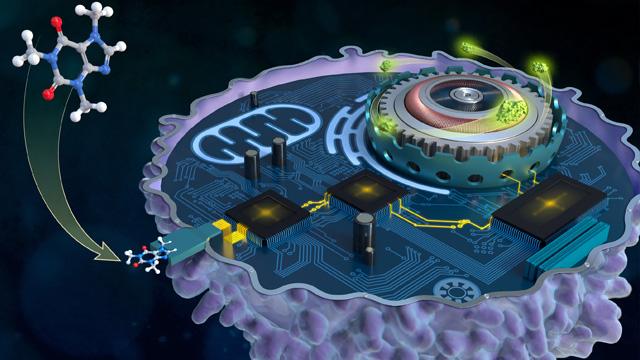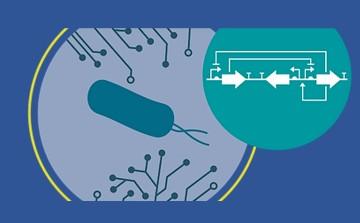- What is synthetic biology?
- How is synthetic biology being used in biomedical research?
- How does NIBIB support synthetic biology research?
What is synthetic biology?
Synthetic biology is the design and construction of new biological parts, devices, and systems and the re-design of existing biological systems. This interdisciplinary field combines principles from biology, engineering, genetics, chemistry, and computer science to either create new biological systems that do not exist in nature or to modify the functions of natural biological systems. A major goal of synthetic biology is to design biological systems in a way that is predictable, robust, and efficient, similar to how machines or circuits are designed in engineering.
Synthetic biology vs. genetic engineering: Genetic engineering is a fundamental tool within the synthetic biology field that predominantly involves making changes to individual or collections of genes in a binary (on/off) manner. In contrast to genetic engineering, synthetic biology adopts systems-level outlook, targeting entire pathways, networks, and whole organisms with quantitative control and modulation.
How is synthetic biology being used in biomedical research?

Engineering immune cells to better fight cancer: CAR T-cell treatment is a type of cancer therapy that modifies a patient's own immune cells to better identify and attack cancer cells within their body. Here’s how it works: T cells, taken from a patient, are engineered to express an artificial protein called a chimeric antigen receptor, or CAR. These artificial receptors are designed to recognize a specific marker, or antigen, found on the surface of a tumor cell. Once infused back into the patient, the CAR T cells can find the tumor by binding to these antigens, ultimately leading to cancer cell death.
Modifying bacteria for diagnostic and therapeutic approaches: While bacteria are traditionally perceived as harmful germs, these organisms can be modified to carry out a wide range of useful functions while also eliminating their toxicity. Researchers are exploring ways to use modified bacteria for a variety of applications, such as delivering drugs to locations in the body that are hard to reach by traditional medicines, or by using engineered bacteria as biosensors to detect the presence of dangerous pathogens.
Designing synthetic biological circuits to direct cells’ abilities: Inspired by electronic circuits, researchers are engineering biological circuits—or interacting molecular pathways—to direct cells to perform specific tasks. Typically, these circuits harness the cell’s native machinery to control things like gene expression, which can amplify or repress the translation (or synthesis) of specific proteins. Controlling multiple genes in concert can affect how a cell functions, triggering responses to specific stimuli or potentially altering its traits or behaviors. Examples of biomedical applications include using cells to generate large amounts of therapeutic proteins, controlling immune cell functions, serving as biomolecular sensors, and more.
Replacing organ functions with synthetic tissues: Organ transplantation remains the gold standard for replacing faulty tissues, but there are numerous problems with this approach, including scarcity of replacement organs and the potential for graft-versus-host disease. Instead of relying on transplants to replace organs, bioengineers are developing synthetic tissues, which may contain live cells in conjunction with synthetic components, such as artificial vasculature and 3D-printed compartments. Thousands of people in the United States die every year waiting for an organ transplant, and synthetic tissues may someday have the potential to save many lives.
How does NIBIB support synthetic biology research?
Engineered bacteria prime tumors for selective elimination: What if bacteria—which love to grow deep inside tumors—could guide cancer therapies directly to their target? A team of NIBIB-funded researchers has engineered a bacterial strain, which selectively colonizes within the tumor core, to “light up” cancer cells with an artificial fluorescent antigen. These synthetic antigens act as a beacon, drawing CAR T cells that have been designed to recognize them to the tumor to effectively attack and destroy it. The technique significantly reduced tumor growth in multiple mouse models, including models of breast and colorectal cancer.

Scientists engineer living DNA sensors: With an eye toward early disease detection, synthetic biology engineers have designed and engineered bacteria that find and detect fragments of DNA shed from infectious pathogens. NIBIB-funded researchers took advantage of the natural ability of a common bacterium (B. subtilis) that captures DNA from its surroundings to design a bacterial DNA sensor. By integrating a series of genes into the B. subtilis genome, the researchers programmed the bacteria to generate a detectable fluorescent signal once it finds the target DNA and pulls it inside of the cell. Because the DNA of a pathogen within an infected individual could be identified before the appearance of symptoms, this system offers the promise of extremely early detection of deadly diseases such as sepsis where rapid detection is critical for successful treatment.
New RNA technology turns cells into long-lasting drug factories: A team of researchers has established an RNA-based method that drives cells in the body to produce therapeutic proteins and secrete them into the bloodstream. The method leverages naturally occurring biomolecules called signal peptides, which determine where newly synthesized proteins are sent within the cell. The researchers wanted to use these “shipping labels” to send proteins that traditionally remain inside of the cell to enter the bloodstream instead, which would improve their therapeutic efficacy. They designed RNA sequences to direct the synthesis of therapeutic proteins that are attached to specific signal peptides, shuttling these biological drugs into the circulation. Experiments in mice revealed beneficial effects in models of both psoriasis and cancer. This type of approach could be especially beneficial for patients who need to take frequent medications via injection.
NIH Synthetic Biology Consortium: NIBIB leads the NIH Synthetic Biology Consortium, which brings together researchers from across NIH to share resources and identify opportunities for collaboration with a focus on providing tools to advance synthetic biology interventions for improving health.
Updated September 2025
